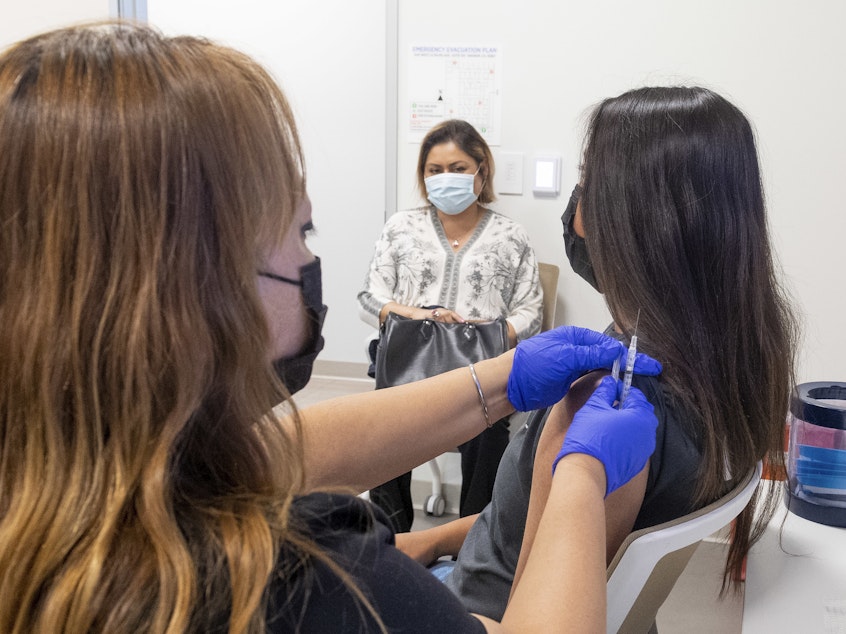Adolescents Can Get Routine Immunizations With Their COVID Shots, CDC Advisers Say

Children's immunizations dropped dramatically during the pandemic, and health officials are eager to get kids caught back up on their routine shots before they return to school.
On Wednesday, the Centers for Disease Control and Prevention recommended that the Pfizer COVID-19 vaccine be given to children ages 12 to 15, opening vaccination to approximately 17 million adolescents. And a CDC advisory committee said health workers can decide to give other needed vaccines, such as for measles and HPV, without waiting two weeks after the COVID shot has been administered.
The American Academy of Pediatrics made a similar recommendation. "Given the importance of routine vaccination and the need for rapid uptake of COVID-19 vaccines, the AAP supports coadministration of routine childhood and adolescent immunizations with COVID-19 vaccines," the academy said.
Dr. José Romero, a pediatrician who chairs the CDC immunization advisory committee and is the Arkansas secretary of health, said, "A lot of our not just adolescents, but children in particular, are behind on their immunizations because of the COVID pandemic."
"They weren't going to regular checkups and regular visits with their doctors," he said in an interview Thursday with NPR's Morning Edition. "So to take advantage of a visit with a physician to administer all vaccines that are necessary at that time is highly advantageous."
Sponsored
A Kaiser Permanente study published in the journal Pediatrics found that "the number of recommended vaccine doses and measles-containing vaccine doses administered to children decreased dramatically" shortly after the national coronavirus state of emergency was declared in March 2020. "While this decrease was modest and recovered rapidly in children [less than 2 years old], it was more severe and persistent in older children."
The researchers found that the decline in vaccinations resulted from the "markedly decreased number of visits" to doctors' offices during the pandemic. Comparing January-August 2020 to the same period in 2019, the researchers found that "well visits" dropped more than 35% and other in-person visits fell nearly 72%.
In the NPR interview, Romero called the move to vaccinate adolescents for COVID-19 "a big, big step forward in achieving large-scale immunity here in this country."
Below are highlights of the interview, edited for length and clarity.
I heard you hesitate to use the word herd immunity.
Sponsored
Right. As you know, it appears that that goal has been modified. And what we're looking for now is achieving a certain amount of individuals that have received at least one dose. I think that that's reasonable at this point and that we need to move forward with reasonable expectations.
On whether state health departments should require kids to get the COVID vaccine as a condition of going to school
The requirement for a vaccine depends on the prevalence of the disease and the severity of disease. Now, if we can bring this under control with routine parental consent to give this vaccine and not mandate it, I think it's possible to do it that way. But we'll have to see how it goes forward.
On how to overcome hesitancy about the COVID vaccine and convince parents that it's safe for their kids
It will take education. And we have programs getting ready and gearing up to do this, to have public messaging of this. Really, the most important people here are the pediatricians, the family practitioners. Those individuals that have a relationship with the parent, the parents trust them. And a recommendation for the use of the vaccine goes a long way.
Sponsored
On concerns over long-term side effects of the COVID vaccine for adolescents
I am not that concerned. Certainly we know that the bridging studies indicate that these vaccines act very similarly or better than adults. I don't think that there's going to be a sudden untoward effect that's discovered. We're going to watch this very closely. As you know, this country has very, very good vaccine safety measures in place. The measures that have caught the allergic reactions and the clotting reactions in adults worked very, very well. [Copyright 2021 NPR]



